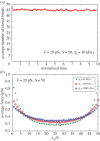A viscoelastic-stochastic model of the effects of cytoskeleton remodelling on cell adhesion
- PMID: 27853571
- PMCID: PMC5098996
- DOI: 10.1098/rsos.160539
A viscoelastic-stochastic model of the effects of cytoskeleton remodelling on cell adhesion
Abstract
Cells can adapt their mechanical properties through cytoskeleton remodelling in response to external stimuli when the cells adhere to the extracellular matrix (ECM). Many studies have investigated the effects of cell and ECM elasticity on cell adhesion. However, experiments determined that cells are viscoelastic and exhibiting stress relaxation, and the mechanism behind the effect of cellular viscoelasticity on the cell adhesion behaviour remains unclear. Therefore, we propose a theoretical model of a cluster of ligand-receptor bonds between two dissimilar viscoelastic media subjected to an applied tensile load. In this model, the distribution of interfacial traction is assumed to follow classical continuum viscoelastic equations, whereas the rupture and rebinding of individual molecular bonds are governed by stochastic equations. On the basis of this model, we determined that viscosity can significantly increase the lifetime, stability and dynamic strength of the adhesion cluster of molecular bonds, because deformation relaxation attributed to the viscoelastic property can increase the rebinding probability of each open bond and reduce the stress concentration in the adhesion area.
Keywords: Monte Carlo simulation; cell adhesion; viscoelastic–stochastic model.
Figures








Similar articles
-
Lifetime and strength of adhesive molecular bond clusters between elastic media.Langmuir. 2008 Feb 19;24(4):1262-70. doi: 10.1021/la702401b. Epub 2008 Jan 8. Langmuir. 2008. PMID: 18179265
-
A viscoelastic-stochastic model of cell adhesion considering matrix morphology and medium viscoelasticity.Soft Matter. 2024 Sep 18;20(36):7270-7283. doi: 10.1039/d4sm00740a. Soft Matter. 2024. PMID: 39239672
-
Lifetime and strength of periodic bond clusters between elastic media under inclined loading.Biophys J. 2009 Nov 4;97(9):2438-45. doi: 10.1016/j.bpj.2009.08.027. Biophys J. 2009. PMID: 19883586 Free PMC article.
-
Probing mechanical principles of focal contacts in cell-matrix adhesion with a coupled stochastic-elastic modelling framework.J R Soc Interface. 2011 Sep 7;8(62):1217-32. doi: 10.1098/rsif.2011.0157. Epub 2011 Jun 1. J R Soc Interface. 2011. PMID: 21632610 Free PMC article. Review.
-
Viscoelastic hydrogels for 3D cell culture.Biomater Sci. 2017 Jul 25;5(8):1480-1490. doi: 10.1039/c7bm00261k. Biomater Sci. 2017. PMID: 28584885 Review.
Cited by
-
Role of Ligand Distribution in the Cytoskeleton-Associated Endocytosis of Ellipsoidal Nanoparticles.Membranes (Basel). 2021 Dec 19;11(12):993. doi: 10.3390/membranes11120993. Membranes (Basel). 2021. PMID: 34940494 Free PMC article.
-
Effects of ligand distribution on receptor-diffusion-mediated cellular uptake of nanoparticles.R Soc Open Sci. 2017 May 31;4(5):170063. doi: 10.1098/rsos.170063. eCollection 2017 May. R Soc Open Sci. 2017. PMID: 28573012 Free PMC article.
-
On modeling the multiscale mechanobiology of soft tissues: Challenges and progress.Biophys Rev (Melville). 2022 Aug 15;3(3):031303. doi: 10.1063/5.0085025. eCollection 2022 Sep. Biophys Rev (Melville). 2022. PMID: 38505274 Free PMC article. Review.
-
Mechanical Model for Catch-Bond-Mediated Cell Adhesion in Shear Flow.Int J Mol Sci. 2020 Jan 16;21(2):584. doi: 10.3390/ijms21020584. Int J Mol Sci. 2020. PMID: 31963253 Free PMC article.
References
-
- Lo CM, Wang HB, Dembo M, Wang YL. 2000. Cell movement is guided by the rigidity of the substrate. Biophys. J. 79, 144–152. (doi:10.1016/S0006-3495(00)76279-5) - DOI - PMC - PubMed
-
- Discher DE, Janmey P, Wang YL. 2005. Tissue cells feel and respond to the stiffness of their substrate. Science 310, 1139–1143. (doi:10.1126/science.1116995) - DOI - PubMed
-
- Peyton SR, Putnam AJ. 2005. Extracellular matrix rigidity governs smooth muscle cell motility in a biphasic fashion. J. Cell. Physiol. 204, 198–209. (doi:10.1002/jcp.20274) - DOI - PubMed
-
- Zhong Y, Ji B. 2014. How do cells produce and regulate the driving force in the process of migration? Eur. Phys. J. Spec. Top. 223, 1373–1390. (doi:10.1140/epjst/e2014-02196-8) - DOI
-
- Engler AJ, Richert L, Wong JY, Picart C, Discher DE. 2004. Surface probe measurements of the elasticity of sectioned tissue, thin gels and polyelectrolyte multilayer films: correlations between substrate stiffness and cell adhesion. Surf. Sci. 570, 142–154. (doi:10.1016/j.susc.2004.06.179) - DOI
LinkOut - more resources
Full Text Sources
Other Literature Sources

